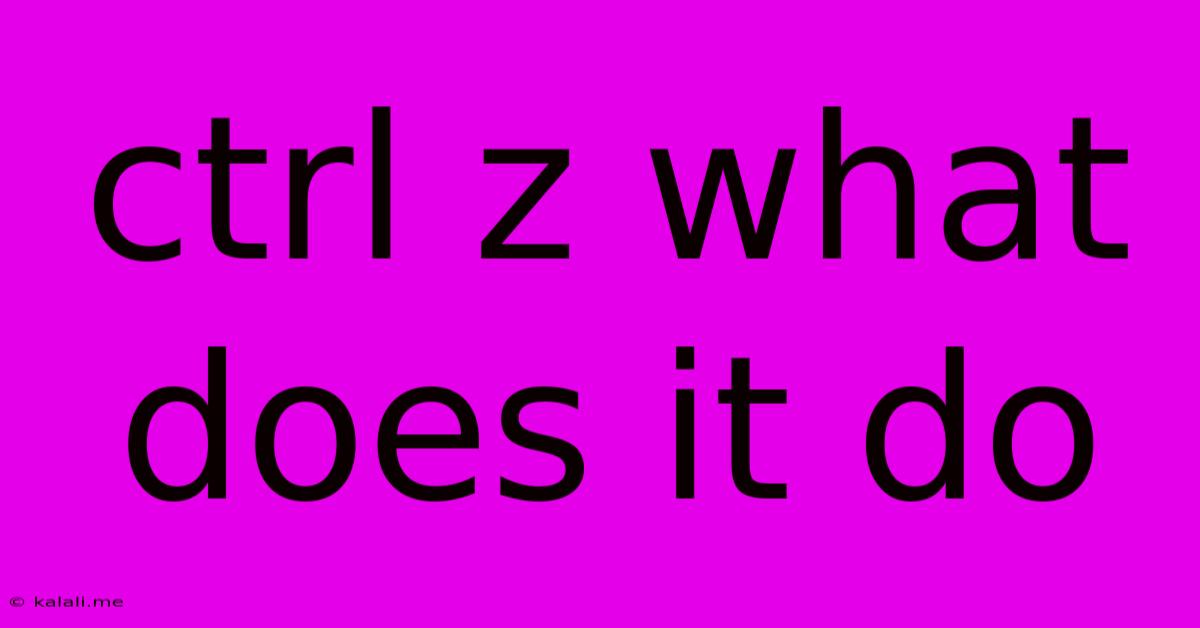Ctrl Z What Does It Do
Kalali
May 21, 2025 · 3 min read

Table of Contents
Ctrl+Z: Your Undo Button and Digital Lifeline
Ever made a mistake while typing, editing a photo, or working on a complex project? That sinking feeling when you realize you've accidentally deleted something crucial? Fear not, digital warriors! The simple keyboard shortcut Ctrl+Z (or Cmd+Z on macOS) is your best friend, your digital safety net, your undo button. This article explores exactly what Ctrl+Z does and its significance in various applications.
This seemingly simple key combination is a cornerstone of modern computing, providing a quick and easy way to reverse your most recent action. It's a feature so ingrained in our workflow that we often take it for granted. But understanding its functionality across different platforms and programs can significantly boost your productivity and reduce frustration.
What Exactly Does Ctrl+Z Do?
At its core, Ctrl+Z functions as an "undo" command. It reverses the last action you performed within a program. This could be anything from deleting a word in a document to moving a layer in photo editing software, or even rearranging files in a folder. The specific action undone depends entirely on the context of the application you're using.
Ctrl+Z Across Different Applications
While the basic functionality remains consistent, the scope of Ctrl+Z varies across different software:
-
Word Processors (Microsoft Word, Google Docs, etc.): Undoes typing, deleting, cutting, pasting, formatting changes, and more. You can often undo multiple actions consecutively by pressing Ctrl+Z repeatedly.
-
Image Editing Software (Photoshop, GIMP, etc.): Reverses brush strokes, layer adjustments, filter applications, and other edits. It's invaluable for non-destructive editing, allowing you to experiment without fear of permanent changes.
-
Code Editors (Visual Studio Code, Sublime Text, etc.): Undoes code deletions, additions, and other edits. Crucial for debugging and refining code without causing irreversible damage.
-
Operating Systems (Windows, macOS): In some instances, Ctrl+Z (or Cmd+Z) can undo file deletions or other system actions, although this functionality is less consistent than in dedicated applications.
-
Web Browsers: While not as universally implemented, some browsers may allow you to undo actions like closing tabs or navigating back to previous pages using Ctrl+Z.
Beyond the Basic Undo: Ctrl+Y (Redo)
Often overlooked, but equally important, is Ctrl+Y (or Cmd+Shift+Z on macOS), the "redo" command. This shortcut reverses the effect of Ctrl+Z, allowing you to reinstate the action you previously undid. This dynamic duo forms a powerful combination for efficient editing and correction.
Limitations of Ctrl+Z
While Ctrl+Z is incredibly useful, it's not a magic wand. There are limitations:
-
Program-Specific Functionality: The scope of undo functionality is dictated by the individual program. Some applications offer more extensive undo history than others.
-
Limited Undo History: Most applications have a limit to how many actions they can undo. Very extensive edits might surpass this limit, meaning some actions can't be reversed.
-
Saving Your Work Regularly: Despite the power of Ctrl+Z, it's crucial to save your work frequently to avoid catastrophic data loss. It serves as a safety net, but not a replacement for regular saving.
In conclusion, Ctrl+Z (or Cmd+Z) is more than just a simple keyboard shortcut; it's a vital tool for anyone who works digitally. Understanding its functionality and limitations can dramatically improve your efficiency and reduce stress. So, embrace the power of undo, and work with confidence knowing that even your biggest mistakes are just a few keystrokes away from being reversed.
Latest Posts
Latest Posts
-
Words That Start And End With The Same Letter
May 21, 2025
-
Metal Gear Solid 5 Mission List
May 21, 2025
-
How To Remove Sink Stopper That Is Stuck
May 21, 2025
-
You Can Please Some Of The People
May 21, 2025
-
Can Plates Be Put In The Oven
May 21, 2025
Related Post
Thank you for visiting our website which covers about Ctrl Z What Does It Do . We hope the information provided has been useful to you. Feel free to contact us if you have any questions or need further assistance. See you next time and don't miss to bookmark.